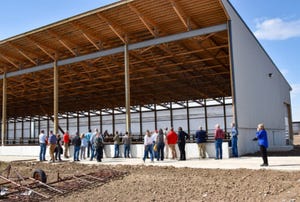Effects of grass silage chop length explored
Longer grass silage chop length found to reduce DMI and milk yield but has little effect on milk fat yield and fatty acid content.

The particle size (PS) of a diet, along with its fiber content, is important for maintaining optimumal rumen function and animal performance. Studies to date largely have focused on the PS of alfalfa and corn silage (CS), with relatively little work occurring on grass silage (GS) PS, even though GS is predominant in the diets of cows in Northern Europe.
The objective of a study reported by Usama Tayyab of Harper Adams University during the American Dairy Science Assn.'s annual meeting in Knoxville, Tenn., was to evaluate the effect of GS chop length and the diet GS:CS ratio on cow performance and milk composition.
For the study, grass was harvested at two theoretical chop lengths -- short, 10 mm, and long, 44 mm -- and mixed with corn silage (GS:CS) at ratios of either 100:0 or 40:60 on a dry matter (DM) basis of DM in isonitrogenous total mixed rations.
Sixteen multiparous Holstein-Friesian cows were used in a 4 x 4 Latin square design with four periods of 28 days duration each. Dry matter intake (DMI), milk yield and milk composition were measured during the final week of each period.
Composite milk samples from four consecutive milkings were extracted and methylated before fatty acid (FA) analysis by gas chromatography.
GS with a short chop length increased (P < 0.04) DMI by 0.9 kg of DM per day compared with the long chop length, Tayyab said. There was an interaction (P < 0.02) between chop length and the GS:CS ratio, with the short-chop length GS increasing milk yield in cows fed the 100:0 diets but not the 40:60 GS:CS diets. There was a tendency (P = 0.09) for a higher milk fat yield (1.2 g/kg) for the long-chop length GS. Cows fed the 40:60 GS:CS diets had higher milk fat concentrations of C18:0 (P < 0.01), C18:2n6 (P < 0.01) and total polyunsaturated fatty acids (P < 0.02) compared with the 100:0 diets, Tayyab said.
The short chop length increased (P < 0.01) the milk C18:3n3 concentration compared with the long chop length, Tayyab noted. Cows fed the 40:60 GS:CS diets had a 1.5 g/kg higher (P < 0.01) milk protein content.
Tayyab reported that a longer GS chop length reduced DMI and milk yield but had little effect on milk fat yield and FA content, while including CS in the diet increased DMI and milk performance, irrespective of the chop length of the GS.
It was also examined how adequate forage chop length (CL) plus sufficient dietary fiber content can benefit the rumen environment and cow performance. Numerous studies have investigated the chop length of alfalfa and corn silage (CS), but there is less research on ryegrass silage (GS), Tayyab said. The goal of this research was to evaluate the effects of GS chop length and the GS:CS ratio on the eating behavior and sorting activity of dairy cows.
For the study, grass silage was chopped at harvest at two mean lengths -- short or long -- and was either fed alone or mixed with CS at a GS:CS ratio of 40:60 (DM basis). All diets were supplemented with concentrates at a ratio of 54:46 (DM basis) and fed as a total mixed ration.
Sixteen multiparous Holstein-Friesian cows were used in a 4 x 4 Latin square design with four periods of 28-day duration in a 2 x 2 factorial arrangement. Jaw activity was visually recorded through instantaneous scan sampling at five-minute intervals for 48 hours. Diet particle distribution was measured at 0 and 24 hours post-feeding for five days using a modified Penn State Particle Separator.
Sorting was calculated as the actual intake of each fraction expressed as a percentage of the predicted intake of each fraction. Values below 100% indicate selective refusals, greater than 100% represent preferential consumption and right at 100% represent no sorting.
Tayyab said data were analyzed using a mixed model procedure. Cows fed GS alone spent 1.1 hours per day longer (P < 0.01) eating compared with those fed the GS:CS mix.
Eating time was 2.84 minutes/kg of DMI higher for the longer-chop length GS compared with the short chop length. In addition, there was an interaction (P < 0.03) for ruminating time (RT) and RT (minutes/kg of DMI), where a longer chop length increased RT of cows fed the GS:CS mix but had little effect when GS was fed alone, Tayyab said.
An interaction (P < 0.01) also was observed for sorting of > 19 mm fraction, where a shorter chop length resulted in a refusals when cows were fed GS alone, but there was no sorting when cows were fed the GS:CS mix. In contrast, Tayyab said, cows fed GS alone had a greater preferential consumption (P < 0.03) for the 4-8 mm fraction.
The conclusion reached in this portion of the study was that a longer GS chop length increased eating time but had no effect on RT. When fed GS as the sole forage source, cows spent a longer time eating and ruminating, and that might benefit rumen function. It also resulted in more diet sorting, Tayyab said.
About the Author(s)
You May Also Like



